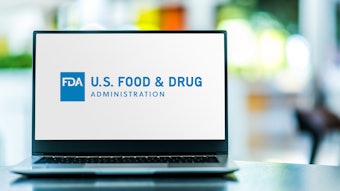In 2004, State Assemblyperson Judy Chu (D–Monterey Park, CA) fired the first bullets at the cosmetics industry by introducing a bill in California to ban certain ingredients from all cosmetics sold in the state.1 Known as Assembly Bill (AB) 2025, it followed the European Union’s (EU) direction to ban cosmetics containing anything on Annex II of the EU Cosmetic Directive. This bill was changed five times before it was passed by the State Senate; however, it was subsequently defeated by a single vote in the Assembly.
Supporters of this legislation learned from its defeat, yet industry manufacturers continued the self-destructive practice of promoting their own products as being safe and their competitors’ as containing “unsafe” ingredients. Terms like sulfate-free, alcohol-free, preservative-free and other free-from marketing claims exploded on the marketplace. Behavior such as this plays right into hands of industry opponents who are pushing for the US Food and Drug Administration’s (FDA) required approval of all cosmetics and cosmetic ingredients prior to their being allowed on the market—ultimately removing all cosmetics from the market.
The second battle again took place in California as others picked up Chu’s fight. State Senator Carole Migden (D–San Francisco) introduced Senate Bill (SB) 484, The Safe Cosmetic Act of 2005. Having learned from previous failure, the authors of SB 484 concentrated on the alleged lack of federal regulations for cosmetics and the claim that the industry uses chemicals “known or suspected of” causing cancer and reproductive harm. Further, Migden claimed that safer raw material alternatives are available, and that SB 484 would not cost more than US $100,000 per year to implement and enforce. This legislation was backed and directed by the Environmental Working Group (EWG) and the justification for it was filled with distortions, half-truths and misleading language (see SB 484 Claims vs. Facts). The bill was passed and signed into law by the governor in 2005,2 which was a major victory for anti-cosmetic forces. The state was then prompted to draw up a list of chemicals whose use in cosmetics or in fragrances used therein would trigger notification to the state. In this author’s view, the state drew up the list not by using common sense but by taking the easy way and listing all the chemicals on California’s Proposition 65 list and anything on any other cited bodies’ list, regardless of whether or not they are used in cosmetics. When the state finally published its list in 2008,3 it included 783 chemicals, of which less than 20 have ever been used in cosmetics. The only chemicals on the list that are important to the cosmetics industry are titanium dioxide, Black 2, cocamide DEA, and retinol and its esters.
At an Independent Cosmetic Manufacturers and Distributors (ICMAD) conference in 2010, a speaker from the California government admitted that the state had been authorized to spend close to US $2 million dollars for the SB 484 program since it was passed—and in this author’s opinion, with nothing to show for it except wasted money and several electronic registrations. Now, the state is bankrupt. Shame on the press for not revealing this crime against the citizens of California.
How did industry respond to SB 484? The Personal Care Products Council (PCPC) issued its Consumer Commitment Code consisting of six parts:
1. Companies should market products only after the safety of each ingredient and the finished product have been substantiated. Ingredient safety can be based on Cosmetic Ingredient Review (CIR) publications.
2. If a company markets a product with an ingredient that exceeds the limits set by the CIR, it should possess sufficient data to substantiate the safety of the ingredient at this level and make this data available to the FDA during an inspection.
3. If a company markets a product with an ingredient the CIR has found to have insufficient data to determine its safety, the company should possess sufficient data to substantiate the ingredient’s safety and make this data available to the FDA during an inspection. 4. Companies should participate in the FDA Voluntary Cosmetic Reporting Program to register a product’s manufacturing location and ingredient usage.
5. The company should notify the FDA of any serious or unexpected adverse events, as defined by the FDA, and make this information available to the FDA during inspections.
6. Companies should maintain safety information about their products and make this information available to the FDA during inspections.
Colorado
Emboldened by the victory of SB 484, the EWG went for the jugular in a third battle against cosmetics in Colorado. On Feb. 22, 2010, Representative Dianne Primavera (D–Broomfield, CO) introduced HB 1248, the Colorado Safe Personal Care Products Act. This author suspects it was no coincidence that during the same time, the PCPC was holding its annual meeting in Florida, and ICMAD was holding its California workshops. With both groups in meetings, their offices were unavailable to react. This bill is surely the new model from the EWG to destroy the cosmetics industry. It plays on the success of California and changes only a few words, which likely were expected to go unnoticed, to add enforcement provisions that would allegedly cost the state nothing. By doing so, this bill would be more palatable to other elected officials in this day of major government deficits.
The provisions prohibit manufacturers from selling, offering for sale, or distributing for sale in Colorado any personal care product that contains a chemical identified as causing cancer or reproductive toxicity. The identification of these chemicals will be determined by authoritative bodies, similar to California SB 484. The definition of personal care products in HB 1248 is the same as the definition under the Food, Drug and Cosmetic Act. Private citizens may file suit to enforce the act and may recover attorney fees and costs if a violation is found. HB 1248 would impose a fine for violation of up to US $5,000 per violation per product for the first offense and US $10,000 for the second and all subsequent offenses. The HB 1248 text states:4
Independent testing in the United States and the European Union has determined that many cosmetic products contain substances known or suspected to cause cancer and reproductive toxicity that can harm adults and children. Neither the federal Food and Drug Administration, nor the Colorado Department of Public Health and Environment require safety testing, review or approval of personal care products such as shampoos, lotions and moisturizers before those products are offered for sale to the public. While most consumers use some personal care products, cosmetic products intended to beautify are most commonly used by women of childbearing age, increasing the likelihood of exposing mothers, fetuses, and nursing children to substances that can cause cancer and reproductive toxicity. Alternatives to chemicals that cause cancer or reproductive toxicity or that contribute to other harmful effects are readily available for use in personal care products.
It continues: Numerous manufacturers, including small domestic producers and large multinational corporations, have eliminated substances that cause cancer or reproductive toxicity from their personal care products. Based on these findings, the General Assembly declares it to be in the best interest of the people of this state to take steps to ensure that personal care products sold and used in this state are safe and do not contain substances that cause cancer or reproductive toxicity.
In addition, the bill describes prohibition and enforcement as follows: Prohibition—sale of personal care products containing unsafe chemicals. On or after Sept. 1, 2011, a manufacturer shall not sell, offer for sale, distribute for sale, or distribute for use in this state any personal care product that contains a chemical identified as causing cancer or reproductive toxicity.
Enforcement by private citizens—civil penalty. Any person alleging a violation of section 25-5-1204 may bring an action against the manufacturer in a court of competent jurisdiction in the county where the violation occurred. Upon finding a violation, in addition to any other relief authorized by law, the court shall order the manufacturer to cease and desist conduct violating section 25-5-1204 and shall order the manufacturer to pay the prevailing party reasonable attorney fees and costs. A manufacturer that violates section 25-5-1204 is subject to a civil penalty of up to five thousand dollars per violation per product for a first offense, and up to ten thousand dollars per violation per product for a second or subsequent offense. Penalties collected pursuant to this section shall be deposited in the general fund.
Of critical importance is definition of manufacturer. According to HB 1248, “Manufacturer” means any person whose name appears on the label of a personal care product pursuant to the requirements of 21 CFR 1.12.
The above reasons and measures for regulating cosmetics are taken from the bill itself. However, in guest commentary to the Denver Post on March 1, 2010,5 Primavera gave some very personal reasons for cosmetics regulation. In her commentary, she noted she was a breast cancer survivor and further stated she did not smoke, was not overweight, and neither her mother nor her grandmother had cancer. She said the doctors had no explanation regarding why a 38-year-old would develop cancer. “Years, later I discovered a possible contributor: my daily use of personal care products.” She continued, “Many products contain ingredients such as formaldehyde, phthalates and coal tar, that (sic) are linked to cancer and birth defects.”5 This is straight out of the EWG’s tactic of distorting the truth. There is no use of anhydrous formaldehyde gas in any cosmetic; phthalates are infrequently used now due to relentless junk science attacks on them, although the FDA and CIR have found them to be safe; and the only use of coal tar is in OTC drugs where the FDA and outside experts have found this to be safe and effective drug active.
Primavera’s commentary continued with her surprise that the FDA does not review the safety of cosmetics before they are placed on the market; it did not include her asking for her federal income taxes to be doubled to pay for this. The fact is that since Japan discontinued its mandatory pre-approval of cosmetics in 2001, no major country requires pre-approval for cosmetics. Further, she stated that, “DEP [(INCI: Diethylhexyl Phthalate)] is used in shampoo, lotion and deodorants.”
Where are her facts supporting this statement? According to the 2005 Frequency of Use report from the FDA,6 no registrations for DEP in cosmetics were reported. Primavera also states, without any evidence, that “almost 40 Colorado companies sell toxic-free products.” However, HB 1248 states that any level of a banned chemical would cause the product to be banned, and it is highly likely that at least one “toxic” substance could be found in parts per billion levels in every product; most anyone can find a single molecule of a given chemical if they have the right tool to measure at such minuscule levels. Just look at what fresh vegetables contain.
Primavera’s last comment regarding DEP is the same distortion of truth the EU used in 2004 to ban ingredients linked to cancer and reproductive harm; both fail to mention the fact that of these banned ingredients, only dibutyl phthalate was ever used in cosmetics and it was applied in nail polish. The CIR7 and even the EU’s scientific committee have found dibutyl phthalate to be safe for this application. Her final statement was: “The evidence linking chemicals in personal care products to cancer is compelling. We must act to protect the safety of Coloradans.” Where’s her proof? She has none. Fortunately, this bill was defeated in committee, 7 to 4. The industry has therefore survived this fight long enough to fight the same battle in other states. Be prepared.
Comments
The EWG took its victory in California and tried to claim another one in Colorado. The first of the two major changes from the California legislation to the Colorado legislation included changing the word ingredient to chemical, which means that finding one part per duotrigintillion (yes, this is a real number—1099 or the last number before one google) of any chemical on the banned list would result in banning the product and large fines. The second change was the added provisions for enforcement in Colorado, which allowed any bounty hunters cashing in on banned ingredient-containing products in California to move to Colorado and terrorize more companies.
Had this bill passed, it probably would have meant that no personal care product would be sold in Colorado. One can only hope that Primavera was prepared to go through life without toothpaste, shampoo, cleansing products, makeup, sunscreens, deodorants and perfumes and bear the brunt of any subsequent effects from the lack of these hygienic products. This author personally contacted the local Denver television stations that reported on this bill when it was introduced to point out the gross distortions and untruthful statements. When asked why they did not question the fraud about to be placed on consumers, they all replied that they just report the news. To this comment, this author responds, “The truth be damned.”
Finally, as a comment regarding Primavera’s personal experience, it is understandable that she is interested in discovering what caused her breast cancer. Everyone hopes the causes are some day found and a cure is developed. However, chasing the cosmetic industry is a disgrace. Why not question the clothes she wears, the car she drives, or the everyday cleaning compounds she uses to clean her dishes, clothes and home? Or, if she truly wants to protect the safety of Coloradans, as she stated, why not ban all tobacco products? Why not make it a criminal offense for pregnant women to consume alcohol? These practices are known, not suspected, to cause cancer and 90% of all reproductive harm.
What about the cosmetics industry? In this author’s opinion, the PCPC’s Consumer Commitment Code really lacks two important additions. One is that all companies should comply with all FDA regulations, which is especially true with regard to ingredient labeling. Marketers tend to ignore the regulations, probably enticed by the lack of enforcement by the FDA, and then wonder why the industry is under attack. When these same marketers try the same thing in Canada and the EU, where labeling regulations are enforced, they are shocked by this enforcement.
The second addition to the PCPC code should be for all companies to refrain from promoting their products as being free from certain ingredients. When competitors make “free-from” claims to give the impression that certain ingredients are unsafe, since the industry is self-regulated, all this does is beg Congress to pass a law requiring the pre-approval of all cosmetic ingredients—and just look at how long the industry has tried to gain approval for new colors or new UV filters that have been around for 30 years. Currently, the time and costs involved for the FDA to approve new ingredients essentially means no new ingredients. While writing the present column, this author heard an ad from one of the largest members of the PCPC claiming that their new shampoo is “sulfate-free,” giving the impression of greater safety. This is self-defeating since their other shampoos contain lauryl and laureth sulfate surfactants, and by the same token must therefore be “unsafe.” In this author’s view, it is also strange that the code requires companies to make available the safety data on their ingredients that has not been submitted to the CIR. Why has this safety data not been submitted to the CIR in the first place? Would it not be better to support the CIR by submitting the data?
References
Send e-mail to [email protected].
1. DC Steinberg, Regulatory review: California update, Cosm & Toil 119 (11) 36-43 (Nov 2004)
2. DC Steinberg, Regulatory review: California revisited, Cosm & Toil 120 (10) 52-60 (Oct 2005)
3. www.cdph.ca.gov/programs/cosmetics/Documents/chemlist.pdf (accessed Apr 6, 2010)
4. www.leg.state.co.us/CLICS/CLICS2010A/csl.nsf/fsbillcont3/ 399D0F36FF7CAE54872576BD006FDDEC?Open&file=1248_01.pdf (accessed Apr 6, 2010)
5. https://www.denverpost.com/search/ci_14488922 (accessed Apr 6, 2010)
6. DC Steinberg, 2005 Preservatives use: Frequency report and registration, Cosm & Toil 121 65 (Jul 2006) 7. CIR, JACT 4(3) 267-303 (1985)







!['I think the biggest game-changer about [MoCRA's] ... requirement for GMPs is how it changes what it means to be adulterated,' Brandi Reinbold, senior manager of global certification for NSF International, said in this sponsored videocast. Register now to watch and learn more. It's free.](https://img.cosmeticsandtoiletries.com/files/base/allured/all/image/2023/11/NSF_Intl_Thumbnail.6554efdc29816.png?auto=format%2Ccompress&fit=crop&h=191&q=70&rect=275%2C70%2C1328%2C748&w=340)


